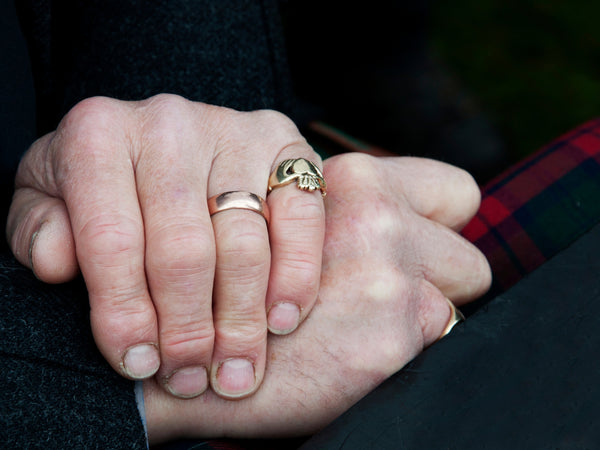
The Beloved Claddagh Ring: Unveiling the Meaning Behind It
In the world of Irish tradition, the Claddagh ring holds an extraordinary place. Steeped in symbolism and history, this beloved ring has captivated hearts across generations. But what is the story behind this iconic piece of jewelry? And what does it represent to those who wear it?
The Claddagh ring originated in the fishing village of Claddagh, located in Galway, Ireland. Its mesmerizing design features a heart, a crown, and two hands embracing the heart. Each element of the ring carries a deep meaning: the heart symbolizes love, the crown represents loyalty, and the hands signify friendship.
Legend has it that the tradition of the Claddagh ring dates back to the 17th century. It is said to have been created by Richard Joyce, a man who was kidnapped and sold into slavery. During his captivity, he crafted the first Claddagh ring as a symbol of his enduring love for his sweetheart back in Ireland.
Today, the Claddagh ring is a cherished token of love, friendship, and loyalty. It is commonly worn as an engagement or wedding ring, as well as a symbol of Irish heritage. Its timeless design and profound meaning continue to capture the imaginations of people around the world.
The History and Origins of the Claddagh Ring

The Claddagh ring is a unique and captivating piece of jewelry that has become a beloved symbol of Irish culture and heritage. Its origins can be traced back to the 17th century, in the fishing village of Claddagh, located in Galway, Ireland.
According to legend, the Claddagh ring was created by a local silversmith named Richard Joyce, who was kidnapped and sold into slavery in the West Indies. During his years in captivity, Joyce crafted the first Claddagh ring, which he intended to present to his sweetheart upon his return to Ireland. The design of the ring, featuring a heart, a crown, and two hands, was a reflection of his unwavering love, loyalty, and friendship.
When Joyce finally returned to Claddagh, he reunited with his beloved and presented her with the now-iconic Claddagh ring. This romantic tale of perseverance and devotion has captivated the hearts of people around the world, and the Claddagh ring has since become a symbol of the enduring spirit of the Irish people.
The Symbolism and Meaning Behind the Claddagh Ring

The Claddagh ring is more than just a beautiful piece of jewelry; it is a symbol rich in meaning and tradition. Each element of the ring's design holds a significant and deeply personal significance.
The heart at the center of the ring represents love, a testament to the wearer's affection and devotion. The crown above the heart symbolizes loyalty, signifying the wearer's commitment to their partner or loved one. The two hands embracing the heart represent friendship, a reminder of the importance of trust and understanding in any relationship.
The orientation of the ring also holds great meaning. When worn with the heart pointing towards the wearer, it signifies that the individual's heart is taken, indicating they are in a committed relationship. Conversely, when the heart points away from the wearer, it suggests that the individual's heart is available, signaling their single status.
The Claddagh ring is not just a symbol of love and loyalty; it is also a reflection of Irish culture and tradition. The design and meaning of the ring have been passed down through generations, making it a cherished heirloom and a tangible connection to the rich history of the Emerald Isle.
Traditional Designs & Variations of the Claddagh Ring

While the classic Claddagh ring design is the most well-known, there are numerous variations and interpretations of this iconic piece of jewelry. Over the centuries, artisans and craftspeople have put their own unique spin on the traditional design, creating a diverse array of Claddagh rings that cater to a wide range of personal styles and preferences.
One of the most common variations is the use of different materials, such as gold, silver, or even more modern materials like titanium or tungsten. The metal used in the ring's construction can greatly influence its overall aesthetic, from the warm tones of yellow gold to the sleek, contemporary look of tungsten.
Another popular variation is the inclusion of additional gemstones or embellishments. Some Claddagh rings feature birthstones or other precious gems set into the heart, crown, or hands, adding a touch of personalization and elegance. Others may incorporate intricate engraving or filigree work, creating a more ornate and decorative design.
Regardless of the specific design, each Claddagh ring remains a unique and meaningful expression of the wearer's personal style and connection to Irish heritage. Whether classic or contemporary, the enduring symbolism of the Claddagh ring continues to captivate and inspire people around the world.
Famous Wearers of the Claddagh Ring

The Claddagh ring has been a cherished symbol of Irish culture and tradition for centuries, and it has been worn by countless individuals who have embraced its timeless beauty and profound meaning. Among the most famous wearers of the Claddagh ring are several notable figures, both historical and contemporary, who have helped to cement its status as a beloved icon.
One of the most well-known Claddagh ring wearers is Queen Victoria, who was gifted a Claddagh ring during a visit to Ireland in the 19th century. The Queen's affinity for the ring helped to popularize it among the aristocracy and the upper classes, further solidifying its status as a symbol of Irish heritage and pride.
In more recent times, the Claddagh ring has been embraced by a wide range of celebrities and public figures, from actors and musicians to politicians and royalty. Actress Saoirse Ronan, known for her roles in films like "Lady Bird" and "Little Women," has been photographed wearing a Claddagh ring, showcasing her Irish roots and connection to the country's cultural traditions.
The Claddagh ring has also been worn by members of the British Royal Family, including Princess Diana and the Duchess of Cambridge, Kate Middleton. These high-profile wearers have helped to further cement the Claddagh ring's status as a timeless and iconic symbol of love, loyalty, and friendship.
How to Wear and Care for a Claddagh Ring

Wearing and caring for a Claddagh ring is a time-honored tradition that carries its own set of guidelines and customs. Properly understanding and adhering to these practices can help ensure that the ring is worn with respect and reverence, and that it remains a cherished possession for years to come.
When it comes to wearing a Claddagh ring, the orientation of the ring holds great significance. Traditionally, the ring is worn on the right hand with the heart pointing outward, indicating that the wearer is single and their heart is available. Once the wearer becomes engaged or married, the ring is typically moved to the left hand, with the heart pointing inward, signifying that their heart is taken.
Proper care and maintenance of a Claddagh ring are also essential to preserving its beauty and longevity. Regular cleaning with a mild soap and water, and the occasional polishing with a soft cloth, can help keep the ring looking its best. It's also important to avoid exposing the ring to harsh chemicals or environments that could potentially damage the metal or gemstones.
For those who wish to pass down their Claddagh ring to future generations, proper storage and handling are crucial. The ring should be kept in a safe, dry place, away from direct sunlight or moisture, to prevent tarnishing or other forms of deterioration. With the right care and attention, a Claddagh ring can become a cherished family heirloom, a tangible connection to the rich history and traditions of Ireland.
The Claddagh Ring as a Cultural and Romantic Symbol

The Claddagh ring has long been a symbol of Irish culture and heritage, but it has also become a beloved symbol of romance and commitment. The ring's enduring popularity and deep-rooted symbolism have made it a cherished token of love and devotion for couples around the world.
For many, the Claddagh ring represents the ultimate expression of love and loyalty. The heart, crown, and hands motif is a powerful visual representation of the values that are essential to a healthy and fulfilling relationship: love, loyalty, and friendship. The ring's ability to convey these sentiments without words has made it a popular choice for engagement and wedding rings, as well as a meaningful gift for anniversaries, birthdays, and other special occasions.
Beyond its romantic associations, the Claddagh ring also serves as a symbol of Irish pride and cultural identity. Wearing a Claddagh ring is a way for individuals to celebrate their Irish heritage and connect with the rich history and traditions of the Emerald Isle. The ring's enduring popularity among the Irish diaspora, as well as those with a deep appreciation for Irish culture, is a testament to its enduring significance as a cultural icon.
Whether used as a symbol of love or a celebration of Irish identity, the Claddagh ring continues to hold a special place in the hearts and minds of people around the world. Its timeless design and profound meaning make it a cherished and enduring symbol of the human experience, transcending cultural boundaries and uniting people in a shared appreciation for the beauty and power of love, loyalty, and friendship.
The Claddagh Ring in Popular Culture and Media

The Claddagh ring's captivating design and rich symbolism have made it a popular fixture in various forms of popular culture and media. From movies and television shows to literature and music, the Claddagh ring has been featured in a wide range of creative works, further solidifying its status as a beloved and instantly recognizable symbol.
One of the most notable examples of the Claddagh ring's presence in popular culture is its appearance in the hit TV series "Buffy the Vampire Slayer." In the show, the character Willow Rosenberg, a powerful witch, is often seen wearing a Claddagh ring, which serves as a visual representation of her character's journey and the importance of love, friendship, and loyalty in her life.
The Claddagh ring has also been featured in numerous films, including the romantic comedy "P.S. I Love You," where the ring plays a central role in the plot. In the movie, the protagonist, played by Hilary Swank, inherits a Claddagh ring from her late husband, which becomes a symbol of their enduring love and a catalyst for her emotional healing.
Beyond the screen, the Claddagh ring has also found its way into literature, with authors such as Maeve Binchy and Nora Roberts incorporating the iconic design into their stories. In Binchy's novel "Circle of Friends," the Claddagh ring serves as a touchstone for the characters, representing the bonds of friendship and the power of love to transcend time and distance.
The Claddagh ring's presence in popular culture and media has not only helped to raise awareness of its significance but has also contributed to its enduring popularity and status as a beloved symbol of Irish heritage and romantic sentiment. As the Claddagh ring continues to captivate audiences and inspire new creative works, its legacy as a timeless and cherished icon is sure to endure.
The Claddagh Ring as a Cherished Irish Tradition

The Claddagh ring is more than just a piece of jewelry; it is a cherished tradition that has been passed down through generations of Irish people. This iconic ring has become a symbol of the country's rich cultural heritage, a tangible representation of the values and beliefs that have shaped the Irish identity.
At the heart of the Claddagh ring's significance is its deep connection to the fishing village of Claddagh, located in Galway, Ireland. It is here that the ring's legendary origins can be traced, with the story of Richard Joyce and his creation of the first Claddagh ring serving as a testament to the enduring spirit and resilience of the Irish people.
The Claddagh ring's enduring popularity and cultural relevance have made it a cherished heirloom, passed down through families and across generations. For many Irish people, both at home and in the diaspora, the Claddagh ring serves as a physical link to their ancestral roots, a reminder of the values and traditions that have shaped their identity.
Beyond its personal significance, the Claddagh ring has also become a symbol of Irish pride and unity on a global scale. As the Irish people have spread throughout the world, the Claddagh ring has become a unifying force, a shared cultural touchstone that celebrates the resilience, creativity, and enduring spirit of the Irish nation.
Whether worn as a symbol of love, friendship, or cultural identity, the Claddagh ring remains a cherished and revered tradition in Irish culture. Its timeless design and profound meaning continue to captivate and inspire people around the world, ensuring that the legacy of this beloved icon will endure for generations to come.
The Enduring Significance of the Claddagh Ring
The Claddagh ring is a truly remarkable and enduring symbol, one that has captured the hearts and imaginations of people around the world. From its humble origins in the fishing village of Claddagh to its status as a beloved icon of Irish culture and heritage, the Claddagh ring's journey is a testament to the power of tradition, the resilience of the human spirit, and the enduring significance of love, loyalty, and friendship.
Through the centuries, the Claddagh ring has evolved and adapted, taking on new forms and interpretations, yet always remaining true to its core symbolism and meaning. Whether worn as an engagement ring, a family heirloom, or a simple expression of one's Irish identity, the Claddagh ring continues to captivate and inspire, transcending cultural boundaries and uniting people in a shared appreciation for the beauty and significance of this cherished tradition.
As we look to the future, it is clear that the Claddagh ring will continue to hold a special place in the hearts and minds of people around the world. Its timeless design and profound meaning will continue to inspire new generations, serving as a reminder of the enduring power of love, loyalty, and friendship, and the deep, unbreakable bond that connects us all to the rich cultural heritage of Ireland.
In the end, the Claddagh ring is not just a piece of jewelry; it is a symbol of the human experience, a testament to the enduring power of tradition and the resilience of the human spirit. And as long as there are hearts to love, crowns to honor, and hands to embrace, the Claddagh ring will continue to shine as a beacon of hope, a reminder of the beauty and wonder that lies at the heart of the human experience.

